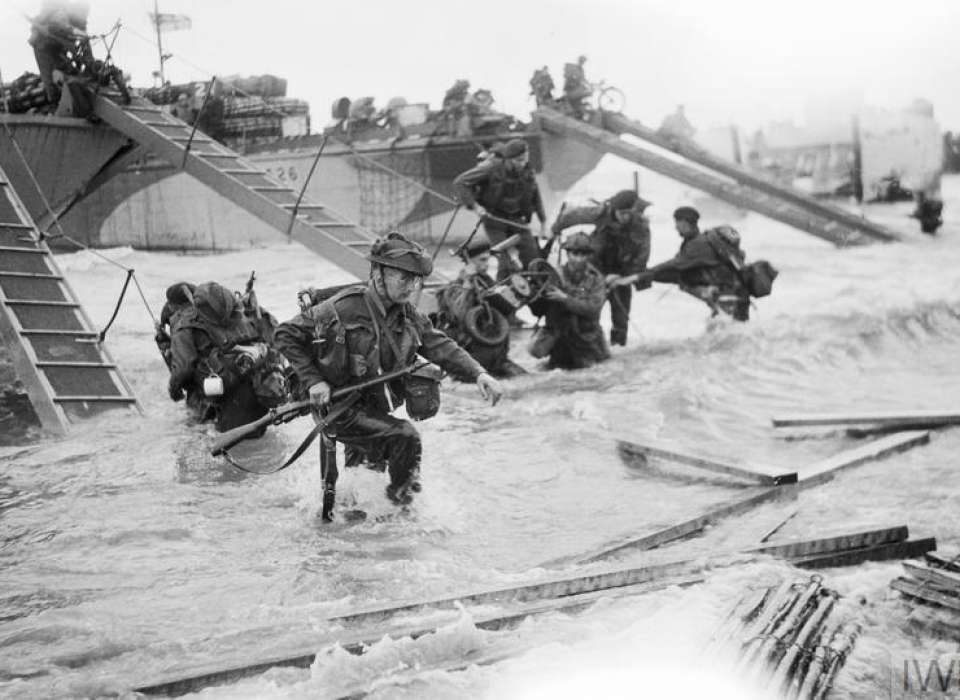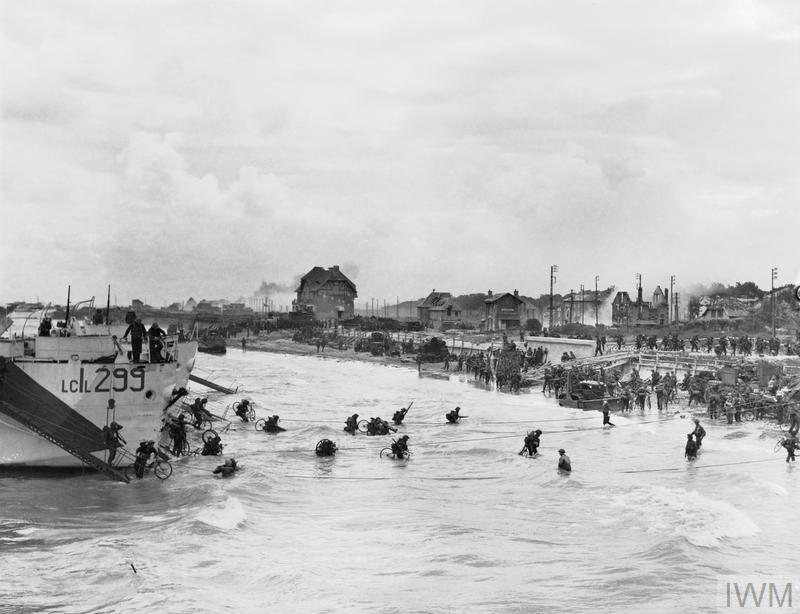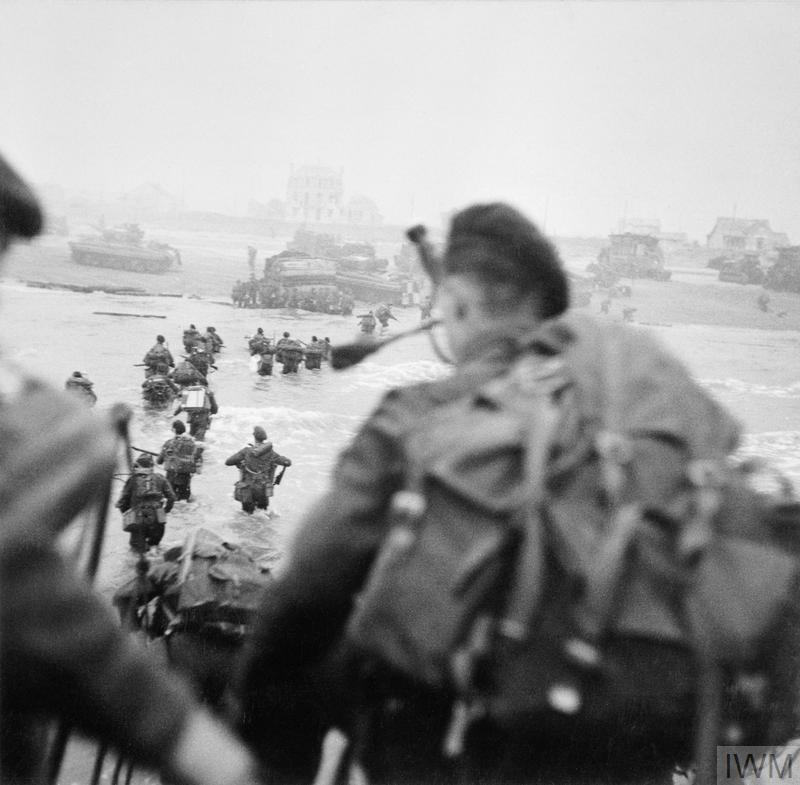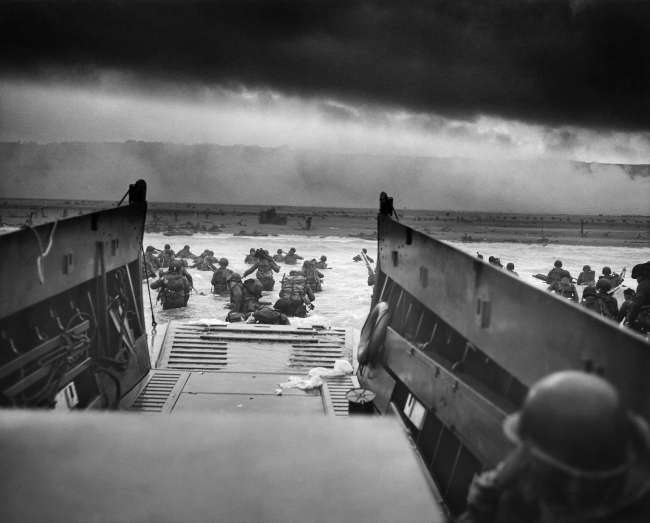Top Photo: Commandos of HQ 4th Special Service Brigade, coming ashore from LCI(S) landing craft on Nan Red beach, Juno area, at St Aubin-sur-Mer, 6 June 1944. Image: IWM (B 5218)
The Allied invasion of France took place on June 6, 1944, along a 50-mile stretch of beach in Normandy. The I and XXX Corps of British Second Army, commanded by Lieutenant General Miles Dempsey, would land to the east on Gold, Juno, and Sword Beaches. The British landing area lay between Port-en-Bessin to the west, where Dempsey’s troops would link up with the Americans, and Ouistreham to the east, where they would link up with 6th British Airborne Division along the Orne River, after their landing to protect the eastern flank of the Allied lodgment.
Dempsey’s troops would face eight German infantry battalions from two divisions. The 716th Infantry Division defended the coast between the Orne River and Le Hamel (on Gold Beach), while the 352nd Infantry Division defended from Le Hamel westward, including part of Omaha Beach. The German defenses included 100 light guns, 50 mortars, and 500 machine guns, supported by 27 batteries of artillery. These were effective units, well supplied with ammunition and backed up by five infantry battalions in reserve.
Allied air strikes and naval gunfire would be essential to the success of the amphibious assault. Air superiority was a significant Allied advantage, limiting the Luftwaffe’s ability to strike against the landing forces while providing a powerful means to attack German forces in the open. Naval gunfire, by contrast, would prove particularly effective against enemy guns mounted in casemates. Engineers, armored forces, and support troops all played key roles as well.
The assault on Gold Beach went quite well, featuring flail tanks that beat paths through enemy minefields. Self-propelled artillery landed mid-morning, providing both close support and counterbattery fire. By the end of D-Day, 25,000 troops had landed on Gold Beach, securing the beachhead and pushing inland to extend the lodgment.
Initially, the situation on Juno Beach looked bleak. The 3rd Canadian Division lost 90 of 306 landing craft to enemy fire, obstacles, and mines, but with the help of armor and naval gunfire, the Canadians broke through the shore defenses by 2 p.m. Ultimately, 21,400 troops landed at Juno Beach on D-Day, despite setbacks that slowed the pace at which follow-on forces could land.
Sword Beach’s narrow frontage limited the British 3d Infantry Division’s initial assault to a single brigade. Still, naval gunfire, armor, and self-propelled artillery provided essential support that enabled the troops to push 1,000 yards inland by 9 a.m. The fighting intensified as front-line forces approached Caen, but armored support arrived in time to repel a counterattack by 90 panzers and two motorized infantry battalions of the 21st Panzer Division. Perhaps most importantly, the 3rd, 6th, and 45th Commandos had marched across the Orne bridges, accompanied by bagpipes, to link up with the 6th Airborne Division, securing the eastern flank of the Allied lodgment.
By June 7, 1944, the British Second Army was firmly established along the Normandy coast, with massive numbers of troops and logistic resources slated to arrive on the beachhead daily. In concert with their American Allies, the British and Canadian forces seized the initiative and progressively drove the Wehrmacht to, and then across, the German border over the coming months. Victory in Europe was finally in view, if still on the horizon.
Mark T. Calhoun, PhD
Mark T. Calhoun, PhD, is a former Senior Historian at the Jenny Craig Institute for the Study of War and Democracy.
Cite this article:
MLA Citation:
APA Citation:
Chicago Style Citation:








![Max Fuchs, New York City cantor, sings as Rabbi Sydney [sic] Lefkowitz, Richmond, VA, conducts the first Jewish services from Germany.](/sites/default/files/styles/max_650x650/public/2025-10/image1.jpg)



